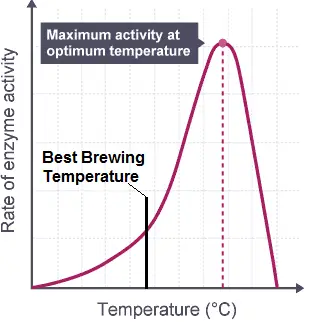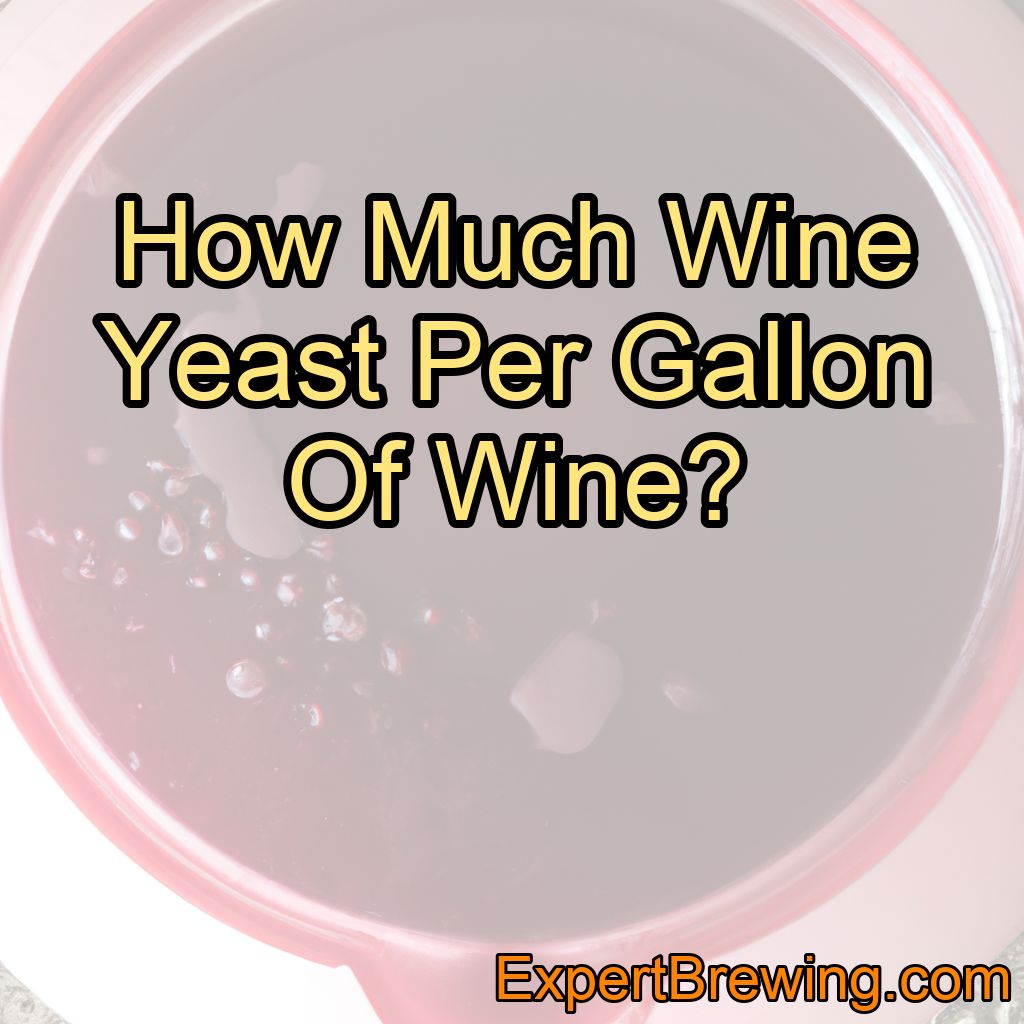As an experienced brewer, I often get asked various questions regarding the wine-making process. One question that comes up quite often is, “how much wine yeast per gallon of wine?” It may seem like a simple question, but the answer may surprise you.
In this blog post, we will delve into the world of wine yeast and discuss its importance in wine-making. We will also explore the factors that determine the right amount of yeast to use, so you can make the best wine possible. So, let’s dive in and find out how much wine yeast per gallon of wine is needed.
The short answer to the question “how much wine yeast per gallon of wine?” is around 1 gram of yeast per gallon of wine. However, the actual amount needed may vary depending on various factors.
The Role of Yeast in Wine-Making
Before we delve into the specifics, it’s essential to understand the role yeast plays in wine-making. Yeast is a single-celled organism that consumes sugar and produces alcohol and carbon dioxide in the process.
This process, known as fermentation, is what turns grape juice into wine. Yeast is also responsible for creating various flavors and aromas in the wine, which is why the choice of yeast is crucial in the wine-making process.

As a brewer, I’ve seen firsthand how the right yeast can make or break a wine. The yeast strain you choose will directly impact the final product’s flavor, aroma, and overall quality. There are hundreds of yeast strains available, each with its unique characteristics, so it’s essential to choose the right one for your specific wine.
Factors That Determine the Amount of Yeast Needed
Several factors determine the amount of yeast needed for a particular wine. Let’s go through each factor in detail to understand how it affects the amount of yeast required.
1. Sugar Content
The sugar content in the grape juice plays a significant role in determining the amount of yeast needed. More sugar means more food for the yeast, which in turn means more yeast is required for fermentation. In general, a higher sugar content will require a higher amount of yeast to ensure complete fermentation.
2. Temperature
Temperature also plays a crucial role in wine fermentation. Yeast is sensitive to temperature, with most strains requiring a specific temperature range to perform optimally.

Higher temperatures can lead to faster fermentation, while lower temperatures can slow down the process. As a result, the amount of yeast needed may vary depending on the fermentation temperature.
3. Nutrient Availability
Yeast requires certain nutrients, such as nitrogen, to thrive and properly ferment the grape juice. The grape juice’s nutrient content can vary depending on various factors, such as grape variety and growing conditions. A juice with low nutrient content may require more yeast to ensure complete fermentation.
4. Desired Fermentation Speed
The speed at which you want the fermentation to occur can also impact the amount of yeast needed. A faster fermentation may require more yeast, while a slower fermentation may require less. It’s essential to strike the right balance, as a fermentation that’s too fast can produce unwanted off-flavors, while one that’s too slow can pose a risk of spoilage.
5. Yeast Strain
As mentioned earlier, the yeast strain can have a significant impact on the wine’s final product. Some strains have a higher alcohol tolerance, while others are more efficient at consuming sugar. The strain chosen can affect the amount of yeast needed to achieve the desired result.
General Guidelines for Wine Yeast Amounts
Now that we understand the factors that can impact the amount of yeast needed for wine-making, let’s look at some general guidelines.
- For most wines, 1 gram of yeast per gallon of wine is a good starting point. This can be adjusted depending on the factors mentioned above.
- When using dry yeast, it’s essential to rehydrate the yeast before adding it to the grape juice. This helps ensure that the yeast is evenly distributed and has a higher chance of successful fermentation.
- Always follow the manufacturer’s instructions on the yeast packaging. Different yeast strains may have specific recommendations for rehydration and usage.
Troubleshooting Fermentation Issues
Sometimes, even with the right amount of yeast, fermentation may not go as planned. Here are some common issues and how to troubleshoot them:
1. Stuck Fermentation
Stuck fermentation occurs when the yeast stops consuming sugar before all the sugar has been converted to alcohol. This can result from several factors, such as temperature fluctuations or nutrient deficiencies. To fix a stuck fermentation, try gently stirring the wine to rouse the yeast or adding additional nutrients, such as yeast nutrient or yeast hulls.
2. Off-Flavors
Off-flavors can be a sign of stressed yeast or issues with the fermentation process. Ensure the fermentation temperature is within the recommended range for the yeast strain and provide sufficient nutrients. Additionally, be cautious about over-pitching yeast, as this can lead to off-flavors as well.
The Importance of Sanitation
No matter how much yeast you use, proper sanitation is crucial to the success of your wine. Any bacteria or wild yeast that find their way into your grape juice can compete with your chosen yeast and potentially spoil the wine. Always sanitize all equipment thoroughly before use and practice good hygiene throughout the wine-making process.
Conclusion
So, how much wine yeast per gallon of wine? The general rule of thumb is to use around 1 gram of yeast per gallon of wine. However, it’s essential to take factors like sugar content, temperature, nutrient availability, desired fermentation speed, and yeast strain into consideration when determining the exact amount needed. Happy wine-making!
Here are 10 quick facts about wine yeast:
1. Yeast is a single-celled organism responsible for fermenting grape juice into wine.
2. There are hundreds of different yeast strains available for wine-making, each with its unique characteristics.
3. The amount of yeast needed can vary depending on factors like sugar content, temperature, and nutrient availability.
4. In general, 1 gram of yeast per gallon of wine is a good starting point.
5. Proper rehydration of dry yeast is essential for successful fermentation.
6. Fermentation speed can impact the amount of yeast needed and the final wine quality.
7. Troubleshooting issues like stuck fermentation or off-flavors may require additional yeast or nutrients.
8. The yeast strain chosen can have a significant impact on the wine’s flavor and aroma.
9. Proper sanitation is critical for the success of your wine.
10. Always follow the manufacturer’s instructions on yeast packaging for optimal results.
FAQs
How many packets of yeast do I need for 6 gallons of wine?
Typically, one packet of yeast is sufficient for up to 5 gallons of wine. Therefore, you would need at least two packets of yeast for 6 gallons of wine.
How much yeast do I need for 1 gallon?
For 1 gallon of beer, you will typically need about 1 packet (11.5 grams) of yeast. However, the exact amount may vary depending on the specific yeast strain and the gravity of your beer.
How much yeast do I need for 6 gallons of wine?
For 6 gallons of wine, you would typically need about 5 grams of yeast. However, the amount of yeast needed can vary depending on the specific recipe and type of yeast being used. It is always best to consult the recipe or instructions provided with the yeast for the recommended amount.
How many packets of yeast do I need for 5 gallons?
For a 5-gallon batch of beer, it is recommended to use one packet of yeast. However, for higher gravity or more complex beers, it may be necessary to use more than one packet or to create a yeast starter.
How much yeast does it take to make a gallon of cider?
Typically, it takes about 1-2 grams of yeast to ferment a gallon of cider, depending on the specific strain of yeast being used and the desired fermentation time.
How much yeast do I use per gallon?
The amount of yeast to use per gallon depends on the type of yeast and the recipe being used. In general, a packet of dry yeast (usually 7 grams) is enough for up to 5 gallons of beer or wine. However, it is always best to follow the specific instructions provided by the yeast manufacturer or recipe to ensure the best results.




